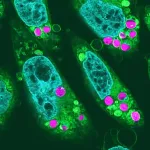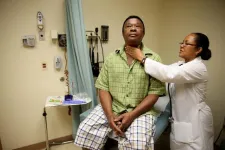(Press-News.org) After a heart attack, aging adults face double or triple the risk of life-threatening complications – like a debilitating stroke or another heart attack – when they move forward with elective noncardiac surgeries too soon, according to new University of Rochester research published in JAMA Surgery.
A deep dive into the Medicare database of 5.2 million surgeries from 2017 to 2020 for patients 67 and older suggests delaying surgery for three to six months following a heart attack, known as a non-ST-segmented elevation myocardial infarction (NSTEMI).
Researchers aim to identify the “sweet spot” for safely scheduling additional surgical procedures in this high-risk population. The study provides valuable analysis to support changes to decision-making guidelines set more than 20 years ago.
“The data physicians are using for patient care decisions today is outdated. Given the advances in care and the ever-changing mix of patients, clinicians need the latest information,” said Laurent Glance, MD, lead author and professor of Anesthesiology and Perioperative Medicine and Public Health Sciences at the University of Rochester Medical Center (URMC).
The 2014 American College of Cardiology and American Heart Association perioperative guidelines call for waiting 60 days after a heart attack before undergoing an elective noncardiac surgery. The recommendation was based on a study of 500,000 patients between 1999 and 2004.
Most post-surgical deaths or significant complications occur during the first 30 days of recovery and perioperative teams work diligently to prevent them. This new analysis shows a decline in risk during the first 90 days, when it leveled off for the next 180 days.
Aging patients often have multiple acute or chronic conditions, and physicians are challenged to balance their risk of surgical care with their expectations for quality of life.
“Perioperative teams analyze a variety of health and lifestyle factors when we assess a patient’s risk and work to optimize their outcomes,” said Marjorie Gloff, MD, a co-author and director of URMC’s Center for Perioperative Medicine. “It can be frustrating for individuals who suffer with joint pain to postpone a long-awaited knee or hip replacement after surviving a heart attack.”
Additional co-authors include Gloff, Heather Lander, MD, Stewart Lustik, MD, Michael Eaton, MD, Sabu Thomas, MD, of URMC; Mark Sorbero, MS, and Andrew Dick, PhD, of RAND Health; Karen E. Joynt Maddox, MD, MPH, of Washington University; Lee Fleisher, MD, of University of Pennsylvania; and Jingjing Shang, PhD, RN, and Patricia Strong, PhD, RN, of Columbia School of Nursing.
This study was supported by funding from the National Institute of Aging, National Institute of Nursing Research and URMC’s Department of Anesthesiology and Perioperative Medicine.
END
Researchers identify “sweet spot” for safe surgery after heart attack
Delaying elective procedures 3 to 6 months reduces risk of complications for aging adults
2024-10-30
ELSE PRESS RELEASES FROM THIS DATE:
Children’s Hospital of Philadelphia researchers identify disparities in healthcare system point of entry for pediatric concussion care
2024-10-30
Philadelphia, October 30, 2024 – Researchers from Children’s Hospital of Philadelphia (CHOP) found that non-Hispanic Black children and those with public insurance and lower Child Opportunity Index (COI) scores were much more likely to seek care for concussions in the emergency department than in primary care or specialty care settings. The findings underscore the need to ensure emergency medicine physicians have specific training and education for diagnosing and managing pediatric concussion and suggest that establishing up-to-date community-level resources could improve care equity for children with possible concussion. The findings were published today by JAMA Network ...
Solar-powered animal cells
2024-10-30
Energy-making chloroplasts from algae have been inserted into hamster cells, enabling the cells to photosynthesize light, according to new research in Japan. It was previously thought that combining chloroplasts (chlorophyll containing structures in the cells of plants and algae) with animal cells was not possible, and that the chloroplasts would not survive or function. However, results showed that photosynthetic action continued for at least two days. This technique could be useful for artificial tissue engineering. ...
ACS research finds lack of health insurance coverage contributes to racial and ethnic disparities in advanced-stage diagnosis of multiple cancers
2024-10-30
A new, large study led by American Cancer Society (ACS) researchers found that lack of health insurance coverage accounts for a significant proportion of racial and ethnic disparities in advanced-stage diagnosis of multiple cancers. The findings are published today in the Journal of the National Cancer Institute (JNCI).
“Health insurance coverage is a key determinant of access to high-quality healthcare across the cancer continuum from prevention to early detection, treatment, and survivorship in the United States,” said Dr. Parichoy Pal Choudhury, Principal Scientist, Biostatistics at the American ...
Exploring the cost and feasibility of battery-electric ships
2024-10-30
— By Jessica Scully
Retrofitting a portion of the US shipping fleet from internal combustion engines to battery-electric systems could significantly reduce greenhouse gas emissions and be largely cost effective by 2035, according to a new study from Berkeley Lab researchers recently published in Nature Energy.
Shipping represents 3% of total US greenhouse gas emissions from transportation, making it an important target for decarbonization. But electrifying ships is more challenging than ...
Scientists say plastic on beaches can now be seen from space
2024-10-30
Australian researchers have developed a new method for spotting plastic rubbish on our beaches and successfully field tested it on a remote stretch of coastline.
The satellite imagery tool developed by RMIT University scientists picks up differences in how sand, water and plastics reflect light, allowing plastics to be spotted on shorelines from more than 600km above.
Satellite technology is already used to track the massive amounts of plastic floating around our oceans – from relatively small drifts containing thousands of plastic bottles, bags and fishing nets, up to gigantic ...
New Starr Cancer Consortium grants awarded to Weill Cornell Medicine researchers
2024-10-30
Three teams led by Weill Cornell Medicine scientists have received awards from the Starr Cancer Consortium in its 17th and final annual grant competition. The grants will fund research on the deep mechanisms of common cancers and related treatment strategies.
The Starr Cancer Consortium, established in 2006 with generous support from The Starr Foundation, includes The Broad Institute of MIT and Harvard, Cold Spring Harbor Laboratory, Memorial Sloan Kettering Cancer Center, The Rockefeller University and Weill Cornell Medicine. The consortium’s goal has been to encourage highly collaborative and transformative research on cancer biology and novel treatment strategies. ...
Researchers aim to spark action to address rising homelessness among older people
2024-10-30
Homelessness among people over the age of 50 is on the rise, a phenomenon formal housing strategies often overlook -- but researchers from the University of Toronto and McGill hope to prevent this oversight in the future.
A new study published in The Gerontologist now provides a clear definition of late life homelessness informed by the lives and experiences of older adults. Drawing on interviews with older people who are unhoused and community workers in Montreal, Canada, the researchers aim to spark ...
Comparative metabolism of the humantenirine in liver microsomes from pigs, goats, and humans
2024-10-30
Background and objectives
Gelsemium elegans Benth (G. elegans) is a traditional medicinal plant; however, it is highly toxic, and toxicity varies significantly between species. The cause of this difference has not been clarified. Humantenirine is an important toxic alkaloid in G. elegans, and its metabolism has been poorly studied. This study aimed to compare the different metabolites formed by human liver microsomes, pig liver microsomes, and goat liver microsomes.
Methods
High-performance liquid chromatography/quadrupole time-of-flight mass spectrometry was used to study the metabolism of humantenirine in human liver microsomes, ...
Some wildfire suppressants contain heavy metals and could contaminate the environment
2024-10-30
In fire-prone areas, water isn’t the only thing used to quell blazes. Wildland firefighters also apply chemical or synthetic suppressants. Researchers reporting in ACS’ Environmental Science & Technology Letters explored whether these suppressants could be a source of elevated metal levels sometimes found in waterways after wildfires are extinguished. Several products they investigated contained high levels of at least one metal, including chromium and cadmium, and could contribute to post-fire increases in the environment.
“Wildfires ...
McMahon receives NIH grant to help build TTUHSC research capacity
2024-10-30
As a leader in academic health and biomedical research training, the Texas Tech University Health Sciences Center (TTUHSC) covers the West Texas region that comprises half of the state’s land mass and is home to 10% of its population. Research at TTUHSC drives innovation and discovery, changing the lives of those it serves and attracting talented faculty, staff and students.
During the latest reporting period (2020-2022), TTUHSC received an average of $12,539,679 annually in National Institutes ...
LAST 30 PRESS RELEASES:
Short-circuiting pancreatic cancer
Groundbreaking mapping: how many ghost particles all the Milky Way’s stars send towards Earth
JBNU researchers propose hierarchical porous copper nanosheet-based triboelectric nanogenerators
A high-protein diet can defeat cholera infection
A more accurate way of calculating the value of a healthy year of life
What causes some people’s gut microbes to produce high alcohol levels?
Global study reveals widespread burning of plastic for heating and cooking
MIT study shows pills that communicate from the stomach could improve medication adherence
Searching for the centromere: diversity in pathways key for cell division
Behind nature’s blueprints
Researchers search for why some people’s gut microbes produce high alcohol levels
Researchers find promising new way to boost the immune response to cancer
Coffee as a staining agent substitute in electron microscopy
Revealing the diversity of olfactory receptors in hagfish and its implications for early vertebrate evolution
Development of an ultrasonic sensor capable of cuffless, non-invasive blood pressure measurement
Longer treatment with medications for opioid use disorder is associated with greater probability of survival
Strategy over morality can help conservation campaigns reduce ivory demand, research shows
Rising temperatures reshape microbial carbon cycling during animal carcass decomposition in water
Achieving ultra-low-power explosive jumps via locust bio-hybrid muscle actuators
Plant-derived phenolic acids revive the power of tetracycline against drug-resistant bacteria
Cooperation: A costly affair in bacterial social behaviour?
Viruses in wastewater: Silent drivers of pollution removal and antibiotic resistance
Sub-iethal water disinfection may accelerate the spread of antibiotic resistance
Three in four new Australian moms struggle with body image
Post-stroke injection protects the brain in preclinical study
Cardiovascular risk score predicts multiple eye diseases
Health: estimated one in ten British adults used or interested in GLP-1 medications for weight loss
Exercise to treat depression yields similar results to therapy
Whooping cough vaccination for pregnant women strengthens babies’ immune system
Dramatic decline in new cases of orphanhood in Uganda driven by HIV treatment and prevention programs
[Press-News.org] Researchers identify “sweet spot” for safe surgery after heart attackDelaying elective procedures 3 to 6 months reduces risk of complications for aging adults



